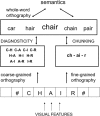A dual-route approach to orthographic processing
- PMID: 21716577
- PMCID: PMC3110785
- DOI: 10.3389/fpsyg.2011.00054
A dual-route approach to orthographic processing
Abstract
In the present theoretical note we examine how different learning constraints, thought to be involved in optimizing the mapping of print to meaning during reading acquisition, might shape the nature of the orthographic code involved in skilled reading. On the one hand, optimization is hypothesized to involve selecting combinations of letters that are the most informative with respect to word identity (diagnosticity constraint), and on the other hand to involve the detection of letter combinations that correspond to pre-existing sublexical phonological and morphological representations (chunking constraint). These two constraints give rise to two different kinds of prelexical orthographic code, a coarse-grained and a fine-grained code, associated with the two routes of a dual-route architecture. Processing along the coarse-grained route optimizes fast access to semantics by using minimal subsets of letters that maximize information with respect to word identity, while coding for approximate within-word letter position independently of letter contiguity. Processing along the fined-grained route, on the other hand, is sensitive to the precise ordering of letters, as well as to position with respect to word beginnings and endings. This enables the chunking of frequently co-occurring contiguous letter combinations that form relevant units for morpho-orthographic processing (prefixes and suffixes) and for the sublexical translation of print to sound (multi-letter graphemes).
Keywords: dual-route theory; orthographic processing; visual word recognition.
Figures






References
-
- Acha J., Perea M. (2008). The effects of length and transposed-letter similarity in lexical decision: evidence with beginning, intermediate, and adult readers. Br. J. Psychol. 99, 245–264 - PubMed
-
- Acha J., Perea M. (2010). Does kaniso activate CASINO? Input coding schemes and phonology in visual-word recognition. Exp. Psychol. 57, 245–251 - PubMed
-
- Andrews S. (1996). Lexical retrieval and selection processes: effects of transposed letter confusability. J. Mem. Lang. 35, 775–800
LinkOut - more resources
Full Text Sources

